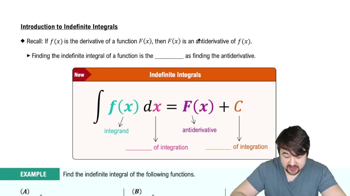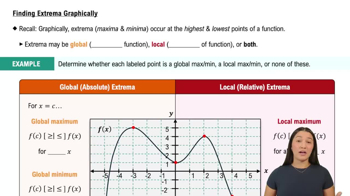Table of contents
- 0. Functions7h 52m
- Introduction to Functions16m
- Piecewise Functions10m
- Properties of Functions9m
- Common Functions1h 8m
- Transformations5m
- Combining Functions27m
- Exponent rules32m
- Exponential Functions28m
- Logarithmic Functions24m
- Properties of Logarithms34m
- Exponential & Logarithmic Equations35m
- Introduction to Trigonometric Functions38m
- Graphs of Trigonometric Functions44m
- Trigonometric Identities47m
- Inverse Trigonometric Functions48m
- 1. Limits and Continuity2h 2m
- 2. Intro to Derivatives1h 33m
- 3. Techniques of Differentiation3h 18m
- 4. Applications of Derivatives2h 38m
- 5. Graphical Applications of Derivatives6h 2m
- 6. Derivatives of Inverse, Exponential, & Logarithmic Functions2h 37m
- 7. Antiderivatives & Indefinite Integrals1h 26m
- 8. Definite Integrals4h 44m
- 9. Graphical Applications of Integrals2h 27m
- 10. Physics Applications of Integrals 2h 22m
5. Graphical Applications of Derivatives
Intro to Extrema
Problem 3.6.60c
Textbook Question
{Use of Tech} Spring runoff The flow of a small stream is monitored for 90 days between May 1 and August 1. The total water that flows past a gauging station is given by v(t) = <matrix 2x2> where V is measured in cubic feet and t is measured in days, with t=0 corresponding to May 1.
c. Describe the flow of the stream over the 3-month period. Specifically, when is the flow rate a maximum?
 Verified step by step guidance
Verified step by step guidance1
To describe the flow of the stream over the 3-month period, we need to analyze the function v(t) that represents the total volume of water that flows past the gauging station. The flow rate of the stream is given by the derivative of v(t), denoted as v'(t).
Calculate the derivative v'(t) to find the flow rate function. This involves differentiating the given function v(t) with respect to time t.
Once you have v'(t), identify the critical points by setting v'(t) = 0 and solving for t. These critical points are potential candidates for maximum or minimum flow rates.
To determine whether each critical point is a maximum or minimum, use the second derivative test. Calculate the second derivative v''(t) and evaluate it at each critical point. If v''(t) is negative at a critical point, the flow rate is at a maximum there.
Finally, evaluate the flow rate at the endpoints of the interval (t = 0 and t = 90) and compare these values with the flow rates at the critical points to determine when the flow rate is at its maximum over the entire 90-day period.
 Verified video answer for a similar problem:
Verified video answer for a similar problem:This video solution was recommended by our tutors as helpful for the problem above
Video duration:
9mPlay a video:
Was this helpful?
Key Concepts
Here are the essential concepts you must grasp in order to answer the question correctly.
Flow Rate
Flow rate refers to the volume of fluid that passes through a given surface per unit of time. In this context, it is essential to understand how the flow rate of the stream varies over the specified period. The flow rate can be represented mathematically as the derivative of the volume function, indicating how quickly water is flowing at any given time.
Recommended video:

Intro To Related Rates
Integration
Integration is a fundamental concept in calculus that allows us to calculate the total accumulation of quantities, such as the total volume of water flowing over time. In this scenario, integrating the flow rate function over the 90-day period will provide the total volume of water that has flowed past the gauging station, which is crucial for understanding the stream's behavior.
Recommended video:

Introduction to Indefinite Integrals
Critical Points
Critical points are values of the independent variable where the derivative of a function is zero or undefined, indicating potential maximum or minimum values. To determine when the flow rate is at its maximum, one must find the critical points of the flow rate function and evaluate them to identify the maximum flow rate during the monitoring period.
Recommended video:

Critical Points

 5:58m
5:58mWatch next
Master Finding Extrema Graphically with a bite sized video explanation from Callie
Start learning





